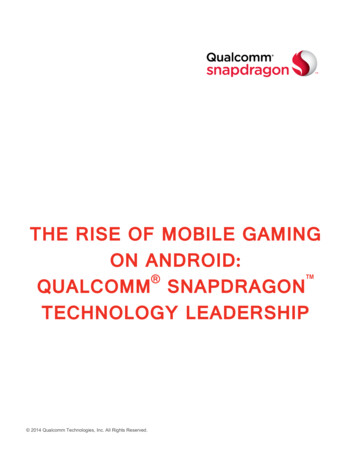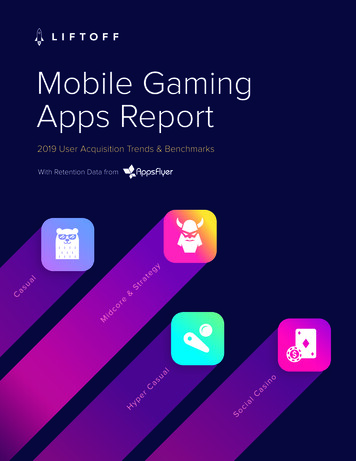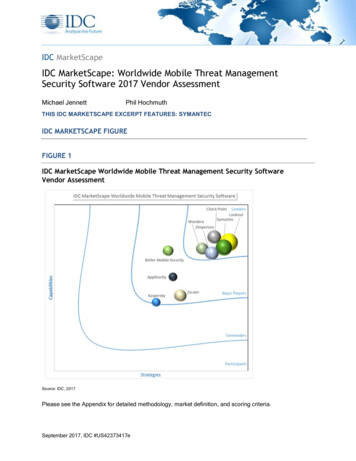
Transcription
THE RISE OF MOBILE GAMINGON ANDROID: QUALCOMM SNAPDRAGONTECHNOLOGY LEADERSHIP 2014 Qualcomm Technologies, Inc. All Rights Reserved.
Qualcomm Technologies, Inc.Qualcomm, Snapdragon, Adreno, FlexRender, Trepn, Vuforia, Brew and Hexagon are trademarks ofQualcomm Incorporated, registered in the United States and other countries. TruPalette, ecoPix, Krait andSmart Terrain are trademarks of Qualcomm Incorporated. All Qualcomm Incorporated trademarks are usedwith permission. AllJoyn is a trademark of Qualcomm Innovation Center, Inc., registered in the United Statesand other countries, used with permission. Other products and brand names may be trademarks orregistered trademarks of their respective owners.Qualcomm Snapdragon, Qualcomm Adreno, Qualcomm TruPalette, Qualcomm ecoPix, FlexRender, Trepn,Brew, Hexagon and Krait are products of Qualcomm Technologies, Inc. Qualcomm Vuforia is a product ofQualcomm Connected Experiences, Inc. Smart Terrain is a feature of the Qualcomm Vuforia SDK. AllJoynopen source project is hosted by the Allseen Alliance.Qualcomm Technologies, Inc.5775 Morehouse DriveSan Diego, CA 92121U.S.A. 2014 Qualcomm Technologies, Inc.All Rights Reserved. 2014 Qualcomm Technologies, Inc. All Rights Reserved.
Table of Contents1Executive summary . 12The rise of mobile gaming on Android. 13Immersive mobile gaming experiences at low power . 24563.1Heterogeneous computing: specialized engines designed for efficient processing . 43.2Efficient SoC architecture: smart management of system resources . 9Providing a consistent development platform at scale. 104.1Android gaming on Snapdragon: an excellent opportunity . 104.2Scalable architecture: consistent gaming experiences across various tiers . 12Unlocking the potential of Snapdragon processors for developers . 125.1Supporting developers with comprehensive tools . 135.2Supporting the developer community. 165.3Next-generation gaming experiences . 17Conclusion . 18 2014 Qualcomm Technologies, Inc. All Rights Reserved.
1 Executive summaryMobile gaming is the fastest growing segment in the game industry. 1 Today’s consumers wantimmersive, connected gaming with all-day battery life that provides visually stunning graphics and highfidelity audio. Android is helping fulfill that desire. With a large user base, Android devices provide agrowing opportunity for game developers to generate revenue on a global scale.The rapid iteration and fast innovation of Android have created a thriving ecosystem with numerouscustom-designed form factors across device tiers. However, there are three challenges to takingAndroid gaming to the next level, including: How to create immersive gaming experiences within the power and thermal constraints ofmobile devices?How to develop a game that addresses a sizeable portion of the mobile gaming segment withminimal code variations?How to take advantage of the hardware’s capabilities without sacrificing time-to-market?Qualcomm Technologies, Inc. (QTI) was the number one provider of Android smartphone applicationprocessor (AP) shipments in 2013. 2 Its Qualcomm Snapdragon processors 3 are fully integratedsystem on a chip (SoC) solutions designed with mobile in mind, handling everything from the mostadvanced, console-quality mobile games to the most popular casual games, all while delivering longbattery life. This paper will describe the rise of mobile gaming on Android and how QTI is meeting thethree challenges by: Creating low-power mobile processors by taking a heterogeneous computing (HC) approachand designing an efficient SoC architecture.Providing a consistent development platform across tiers due to its scalable architecture.Offering tools, support, and advanced technologies to easily unlock the full potential ofSnapdragon processors for developers.2 The rise of mobile gaming on AndroidMobile gaming is the fastest growing segment in the game industry, with a 30% compound annualrevenue growth rate projected from 2013 to 2015.1Android burst onto the scene in 2008. The open nature and rapid iteration of the platform, combinedwith improving hardware, and a growing installed base of devices worldwide, has created excellentopportunities for the mobile gaming ecosystem.123Source: Gartner, October 2013, “Forecast Video Game Ecosystem Worldwide”Source: Strategy Analytics, April 2014Snapdragon processors extend across four product tiers: Snapdragon 800, Snapdragon 600, Snapdragon 400, and Snapdragon 200. 2014 Qualcomm Technologies, Inc. All Rights Reserved.1
Through standard application program interfaces (APIs), Android exposes key platform capabilities todevelopers, such as connectivity, sensors, and graphics rendering. Android also has a history of quicklyadopting the latest graphics standards, like OpenGL ES. The consistent release of new APIs helps limitfragmentation, improve ease of use, and decrease time-to market.To take advantage of increasing consumer engagement on the Google Play app store, developers arenow creating games that utilize the latest Android capabilities (e.g., 3D graphics). As a result, newgame brands have been introduced (e.g., Real Soccer, Asphalt, Real Racing, and Modern Combat).Debuting in the smartphone, Android is now extending to other form factors, including tablets, handheldgaming devices, set-top-boxes, TVs, and more.Total mobile gaming revenues (for all platforms) are projected to grow from 13 billion in 2013 to 22billion in 2015 4. Within this category, the Android platform provides a large and growing opportunity fordevelopers. On the device side, 78.4% of smartphones shipped last year were Android, outsellingdevices based on the next leading smartphone mobile OS by almost 5x. 5 Android device shipments(smartphones and tablets) are projected to exceed one billion units in 2014. 6 On the apps side, 75% ofAndroid users play games 7, accounting for 90% of the app-generated revenue on Google Play 8.3 Immersive mobile gaming experiences at low powerImmersive gaming requires more than just console-quality graphics. Other elements include cinemaquality sound, realistic effects, instantaneous response times (low latency), and the ability to playanywhere. Figure 1 highlights the key components that contribute to the overall gaming experience.Figure 1: Example of key gaming components in Modern Combat 5: Blackout by Gameloft45678Gartner, October 2013, “Forecast Video Game Ecosystem Worldwide”Gartner, “Gartner Says Annual Smartphone Sales Surpassed Sales of Feature Phones for the First Time in 2013”Gartner, “Gartner Says Worldwide Traditional PC, Tablet, Ultramobile and Mobile Phone Shipments On Pace to Grow 7.6% in 2014”Kris Holt, “Google Adds Some Serious Oomph to Play Games”eMarketer, “Game Apps Are No. 1 for Amazon, Apple and Google” 2014 Qualcomm Technologies, Inc. All Rights Reserved.2
Today’s mobile graphics are approaching the visual quality of consoles and PCs with high-end graphicscards.Figure 2: Mobile (left) vs. PC (right) rendering for Epic Unreal Engine 4Consumers expect console-quality graphics and long battery life when playing any mobile game, fromsimple casual games like Candy Crush to more immersive games like Modern Combat 5: Blackout.However, enabling advanced mobile gaming experiences for sustained periods is challenging.Consoles and PCs have the luxury of being able to use fans (and large heat sinks) while drawing tripledigit wattages from an external power outlet. Mobile devices, on the other hand, are passively cooled,powered by a battery, and limited to single-digit wattages in order to meet the power and thermalconstraints of the thin form factor.Through its Snapdragon processors, QTI is addressing the performance and power challenge by: Taking a power-optimized, heterogeneous approach to mobile computing.Analyzing performance bottlenecks and designing an efficient SoC architecture that improveseach generation.“Qualcomm Snapdragon processors reallyhelp enable us to create an immersiveexperience for the gamer.”Sylvain BaudryBusiness Development DirectorGameloftFigure 3: Asphalt 8: Airborne by Gameloft 2014 Qualcomm Technologies, Inc. All Rights Reserved.3
3.1 Heterogeneous computing: specialized engines designed for efficientprocessingQTI has a long history of taking a heterogeneous computing approach. This approach intelligentlyutilizes specialized engines, such as the GPU, DSP, and display engine, to support new immersiveexperiences, while helping to maximize battery life and thermal efficiency.Figure 4: Snapdragon processing enginesAs mentioned in Section 3, games are comprised of multiple components. These components may beimplemented as one or more tasks. To support the optimal gaming experience at the lowest power andthermal levels, each task should be designed to run on the most appropriate engine. Figure 5 is anexample of this.Figure 5: High-level view of gaming tasks being appropriately distributed to specialized engines 2014 Qualcomm Technologies, Inc. All Rights Reserved.4
The rest of this section provides examples of how Snapdragon processors are designed to run keygaming tasks on the most appropriate processing engines.Controlling gameplay execution — keeping everything in sync: The CPU dispatches work to theappropriate specialized engine and processes individual functions within the game as separate tasks.For example AI, animation, physics, and gameplay are processed on the CPU.Functions like physics and AI require high-precision math, which can be efficiently processed on theVeNum floating point units of QTI’s custom-designed Krait CPU. In addition, because the tasks areindependent, they can be written as separate threads and run on separate CPUs for optimalperformance and latency.QTI has been innovating its power management and scheduling software for years to provide thedifferent amounts of processing that various tasks require. For example, Krait CPUs have longemployed asynchronous symmetric multi-processing (aSMP) so that optimized performance isdelivered per CPU core, thus saving power.Console-quality graphics — advanced features and graphics rendering (at low power): Whenmost people think of modern mobile gaming, it is the console-quality graphics that immediately come tomind. Rendering graphics at low power and at high frame rates requires a specialized engine, the GPU.QTI’s custom-designed Qualcomm Adreno GPUs are a family of low power, fully programmableGPUs that are designed for optimal mobile gaming performance.Adreno GPUs provide comprehensive support for the latest graphics APIs. The Khronos OpenGL ESspecifications define the primary graphics APIs for Android gaming. QTI works closely with the Khronosgroup to help define the standards, and the Adreno GPU is optimized to support OpenGL ES (from thesilicon to the drivers and software stack).Adreno GPUs have a long history of graphics technology leadership. They support many designinnovations for efficient graphics processing, including a flexible, power-efficient unified shaderarchitecture, which is designed to support dynamic resource allocation (for optimal shader processing).“Epic now has brought Unreal Engine 4 to Android with the Snapdragon 800 and 805 chipsetsfrom Qualcomm Technologies. Recently we worked with Qualcomm [Technologies] to elevategraphics to the next level on the Adreno GPU hardware, which delivers some of the mostpower-efficient unified shader capabilities we’ve seen yet for Android smartphones and tablets.”— Niklas “Smedis” Smedberg, Epic GamesThe Adreno GPU also supports dynamic FlexRender technology, which is designed to intelligentlychoose between immediate/direct mode and deferred/tile-based rendering, to render various tasks(such as user interface and gameplay) in a more efficient manner.Custom designing the Adreno GPUs allows QTI to evolve the architecture in a timely manner foremerging mobile use cases, such as new gaming features and APIs. For example, the newest Adreno4x series GPUs are designed to the DirectX11FL 11 2 specification, the same graphics specificationas today’s high-end desktop graphics cards and the latest gaming consoles. 2014 Qualcomm Technologies, Inc. All Rights Reserved.5
To support next-gen features (beyond the newly announced Khronos OpenGL ES 3.1 APIs), Adreno 4xseries GPUs extended their unified shader architecture by adding several completely new shaders(e.g., geometry and tessellation).Figure 6: Adreno 4x series GPU’s DirectX11 FL 12 based 3D hardware pipelineThe Adreno 420 GPU is one of the first commercial mobile GPUs to support dynamic hardwaretessellation. Dynamic hardware tessellation is designed to help developers to provide greater detail formore visually realistic scenes in a manner that requires less memory bandwidth, lower powerconsumption, and lower overall memory footprint for the application.Traditionally, in order for most 3D games to be visually immersive, the programmer must include asubstantial amount of geometry detail per object. The denser the geometric mesh used to create anobject in the scene (human or monster for example) of a game, the smoother and more realistic itssurfaces will look. In traditional mobile GPUs, these additional geometry assets (required for improvedvisual realism) need to be stored in memory as part of the game binary package. These assets have tobe copied or written by the CPU to the system memory and eventually have to be read into the GPU forfurther processing. These additional read and write operations could increase the memory bandwidthusage and power consumption to unsustainable levels (for console-quality games) on mobile devices.Dynamic hardware tessellation helps solve this problem by allowing the GPU to generate additionalgeometry on-chip, without requiring additional data transfers from off-chip, system memory. Dynamichardware tessellation can help significantly reduce bandwidth and power consumption. Anotheradvantage is that the developer doesn’t have to author and store these additional geometry details intotheir game package, which significantly reduces the memory footprint and the overall binary size of thegame. 2014 Qualcomm Technologies, Inc. All Rights Reserved.6
The image below shows the additional detail that tessellation provides to both the wireframe and thefinal image rendered. For this simple “Hornet” graphics scene, hardware tessellation delivers abandwidth savings of 360MB/s, and a memory footprint savings of 20MB 9. For larger games, thesavings on memory footprint could be in GBs.Figure 7: Tessellation (OFF: left, ON: right) provides more realistic and detailed graphicsBy providing more detail, tessellation is designed to help significantly improve the gaming experience,not only for high resolution content, but also for low resolution content that needs to be upscaled.The Adreno 4x series GPUs are a great example of QTI’s commitment to bringing console-qualitygaming up to 4K Ultra HD (4K) resolution to mobile devices.“[Adreno 420 is] the most aggressive move in mobile graphics by any company, to add all theshader types, and HW tessellation, on top of what they did in Subdiv for Motorola, showsQualcomm [Technologies] as the most committed mobile graphics supplier today. It really isbringing console-class graphics to mobile devices.”10 — Jon Peddie, Jon Peddie Research.Multi-screen experiences — high fidelity on your screens: Playing a game on a high-quality, highresolution screen significantly enhances the gaming experience. The display engine enhances images,composites multiple images, and supports high resolution (both on-device and on external displays) ofup to 4K.For image enhancement, the display engine utilizes QTI’s Qualcomm TruPalette and Qualcomm EcoPix feature sets, which include high quality post-processing algorithms for superior picture quality,including picture adjustment, color enhancement, contrast enhancement, scaling, sharpening, andpower efficiency. For example, using the ecoPix sunlight visibility improvement technology, the displayengine can use information from the device’s light sensor to enhance the rendered game content tomake it much more visible in bright conditions (e.g., outdoors on a sunny day) through tone correction.910Numbers based on QTI internal testingJon Peddie, “Qualcomm Moves to 4K with Snapdragon 805” 2014 Qualcomm Technologies, Inc. All Rights Reserved.7
Figure 8: Snapdragon display engine TruPalette and EcoPix feature setsDevice-to-device connectivity further elevates the mobile gaming experience. External displays, suchas a TV, are driven by either a wired (e.g., HDMI) or wireless connection (e.g., Miracast). It is the taskof the display engine to efficiently process both types of connections. With the wireless display feature,you can send the contents of your mobile device screen to your smart TV screen. QTI supportswireless display standards, like Miracast, and is adding wireless display support to an increasingnumber of Android devices.Cinema-quality sound — efficient audio processing in sync with the graphics: Just as sound is ahuge part of the movie-going experience, it is also important in the world of immersive mobile gaming.Accordingly, QTI provides a comprehensive audio solution, including hardware and software, whichoffers high-fidelity audio and advanced features like 24-bit/96kHz play back and cinema-quality 7.1surround sound audio.The processing required to efficiently support these computationally complex audio features is primarilyhandled by QTI’s Hexagon DSP, which is custom designed for heavy signal processing tasks, likeaudio. The real-time processing capabilities of QTI’s Hexagon DSP are designed to keep the audio insync with the graphics rendering. QTI has also worked with industry leaders, such as DTS and Dolby,to provide an optimal audio experience on Snapdragon processors, including support for headphonesurround virtualization.High-quality video — specialized video engine: Some games incorporate pre-rendered cut scenesto enhance the overall gaming experience. To save memory, these scenes are compressed intoencoded video. To playback video, Snapdragon processors are designed to use a specialized videoengine to decompress encoded videos at low power. For higher resolutions and more complex codecs,a specialized engine becomes even more important.Figure 9 shows that running H.265 HEVC decode on a specialized video engine versus a CPU reducespower consumption, while still meeting the frame rate requirements 11.11Estimated numbers based on QTI internal testing 2014 Qualcomm Technologies, Inc. All Rights Reserved.8
Figure 9: Power reduction by running HEVC decode on specialized video engine versus the CPUFast connectivity — multi-player gaming: Connected gaming experiences, like massively multiplayeronline (MMO) games, require fast and reliable connectivity solutions with low latency where thedifference between winning and losing often comes down to milliseconds. To achieve that, Snapdragonprocessors include connectivity technologies, such as 802.11ac Wi-Fi and 3G/4G LTE.QTI has a long history of being an industry leader in advanced connectivity solutions. Its latestSnapdragon 810 processor continues the tradition, integrating a Cat 6 LTE Advanced multimodemodem that is designed to support reliable communication at speeds of up to 300 Mbps. QTI optimizesthe software stack for connectivity to achieve low client-server ping times on Snapdragon processors,so gamers can worry less about a slow connection and focus more on enjoying the game.Responsive and accurate control — supporting multiple input methods: A good gamingexperience requires an input method that gives precise control at low latency. There are multiple waysto control and interface to games, such as through a touch screen, device movement, a gamecontroller, and gestures. Snapdragon processors have been designed to reduce latency and provideaccurate control for these methods. For example, device movement generally is determined byprocessing data from motion sensors, such as the accelerometer or gyroscope. Sensor processingrequires intensive signal processing, control processing, and real-time processing. QTI’s specializedsensor engine, which excels at handling these tasks, is integrated in Snapdragon processors. As aresult, the response time for device movement is faster — and at low power.3.2 Efficient SoC architecture: smart management of system resourcesAn efficient SoC architecture is required in order to sustain console-quality gaming at high frame rateswithin the thermal and power constraints of mobile devices. As noted above, the majority of theprocessing engines within the SoC are running concurrently in a heterogeneous manner to efficientlyprocess gaming tasks. Beyond heterogeneous computing, smartly managing the shared systemresources, such as memory bandwidth, power budget, and thermal budget, is necessary to supportsustained gameplay of a visually complex game. 2014 Qualcomm Technologies, Inc. All Rights Reserved.9
Efficient memory bandwidth: While playing a game, the processing engines need to be fed data(starving a processing engine of data can lead to lower frame rates). To prevent bottlenecks,Snapdragon processors use advanced memory management techniques. The memory controller isdesigned to deliver high quality of service (QoS) for different throughput and latency requirements ofdifferent processing engines, while still maximizing the memory utilization. By minimizing the overheadassociated with memory transactions, the memory controller helps increase memory utilization andminimizes power consumption.Snapdragon processors are also designed to deploy smart caching mechanisms in many processingengines to help minimize the need for frequent DRAM access. For example, the Adreno GPU’s tilebased architecture, which subdivides the graphics image into smaller tiles and renders them to the tilebuffer cache, helps minimize DRAM bandwidth and saves power.Advanced power and thermal management technology: Drawing high power not only reducesbattery life, it also releases excess heat. This will raise the skin temperature of the device, making ituncomfortable to hold. To reduce the system power, Snapdragon processors are designed to deploysophisticated algorithms that manage power based on workload requirements. They support a widerange Dynamic Clock and Voltage Scaling (DCVS). DCVS dynamically varies the clock frequencies andvoltages of the processing engines. For example, the Adreno 420 GPU now has more granular DCVSpower control levels, so it can run most use cases at a nominal voltage state, thus saving power.Several of the specialized engines have innovative, power-saving techniques. For example, the displayengine also uses a proprietary compression scheme called Frame Buffer Compression (FBC), whichcompresses display data by up to 66% in a visually lossless manner—before transmission to thedisplay panel. 12The Adreno 420 GPU also has an increased Z-reject rate for graphics rendering so that pixels that arenot going to be visible (because they are blocked by a pixel on top) are not processed. An increased Zreject rate means lower power per pixel—and improved performance.4 Providing a consistent development platform at scaleTo attract game developers, devices with Snapdragon processors provide an excellent opportunity witha consistent development environment.4.1 Android gaming on Snapdragon: an excellent opportunityAs of January 2014, over 1,350 devices with Snapdragon processors had been announced or werecommercially shipping. In addition, more than 525 new device designs are in development, and QTI iscurrently working with over 85 manufacturers worldwide. QTI was the #1 provider of Androidsmartphone AP shipments in 2013. 131213QTI internal metricsStrategy Analytics, April 2014 2014 Qualcomm Technologies, Inc. All Rights Reserved.10
By optimizing their games on Snapdragon processors, developers have the opportunity to reach thisvery large and growing installed base of Android devices with Snapdragon processors that span acrossvarious price tiers and regions.Figure 10: Devices with Snapdragon processorsExamples include iconic flagship Android-based devices like the Nexus 5 by Google, LG G Pro2, andSamsung Galaxy Note 3. Recently launched devices, including the HTC One (M8), One One, LG G3,Samsung Galaxy S5, and the Sony Xperia Z2, are powered by the Snapdragon 801 processor.Amazon Kindle Fire HDX 8.9 and Fire TV, based on Fire OS, are also powered by Snapdragonprocessors.Refer to the smartphones and tablets websites for the latest devices powered by Snapdragonprocessors. With Adreno 4x series GPUs on the verge of being launched in commercial devices,Snapdragon processors continue to provide graphics and gaming technology leadership.According to Jon Peddie Research, “Qualcomm [Technologies] is clearly the largest SoC supplier”.14For Q2 2013 and as indicated in Figure 11, QTI was the single largest GPU supplier for personaldevices, which includes smartphones, tablets, and dedicated handheld game consoles. 14Figure 11: Share of personal systems SoCsuppliers for Q2 201314Jon Peddie Research, Oct. 2013, “Mobile Devices and the GPUs inside” 2014 Qualcomm Technologies, Inc. All Rights Reserved.11
4.2 Scalable architecture: consistent gaming experiences across various tiersConsumers expect immersive gaming experiences whether they own a premium or an entry-levelmobile device. Snapdragon processors are designed to support great gaming experiences across thespectrum of device tiers. Apart from offering backwards-compatible software between different tiers,Snapdragon processors with the scalable Adreno GPU are designed to provide consistent features andAPIs across tiers. Using APIs as an example, Adreno 3x series GPUs (and above) support OpenGL ES3.0. Having common support of APIs and features ranging from entry-level to premium devices helpsmake it easier for developers to introduce next-generation features to mass audiences, without havingto custom design for each tier.Figure 12: Snapdragon processors with the scalable Adreno GPU are designed toprovide consistent features across tiersSnapdragon processors are software compatible, helping both OEMs and developers to efficientlyinvest and develop across multiple device types and tiers. With a consistent software stack, includinggraphics drivers, devices with Snapdragon processors are designed to provide a consistent andoptimized gaming platform across various tiers.5 Unlocking the potential of Snapdragon processors fordevelopersQTI and its affiliates have a long history of technology leadership in supporting the mobile gamingecosystem, dating back to 2001 with the Brew platform. This breakthrough development platformallowed native C/C games to be written “closer to the metal,” supporting higher-quality and higherperformance games, and helped usher in some of the world’s first 3D games in mobile. Brew was alsoone of the earliest monetization platforms for mobile applications, paying out more than 3 billion todevelopers 15.15https://www.brewmp.com/about 2014 Qualcomm Technologies, Inc. All Rights Reserved.12
The introduction of 3G in the early 2000s enabled faster downloads of larger games, multi-playergaming, and more robust client-server-based game designs. In addition, Qualcomm Ventures alsohelped fund mobile gaming pioneers such as JAMDAT Mobile and more recently invested in companiessuch as Bluestacks, Gaikai, Grand Cru, Playdek, Playnery, and TabTale.It takes more than just great hardware to advance the mobile gaming industry. To support gamedevelopers in producing immersive games, QTI provides comprehensive tools, extensive support, andadvanced technologies.5.1 Supporting developers with comprehensive toolsQTI supports developers in unlocking the performance and advanced features of Snapdragonprocessors by not only offering comprehensive development tools, but by also working closely with thegaming ecosystem.Game engine optimization — access to the latest features and reduced time-to-market: QTIworks closely with the world’s leading third-party game engine providers, such as Unity Technologiesand Epic Games, to optimize their engines for Snapdragon processors. Additionally, QTI helps exposethe latest graphics APIs and advanced features of Adreno GPUs to developers through these engines.For example, QTI worked closely with Epic Games to optimize Unreal Engine’s advanced lighting andpost processing pipeline for Snapdragon processors.“Bringing Unreal Engine 4 PC AAA graphics tomobile has enabled us to do content thatwe’ve never been able to do before. A bigadvantage has been our close relationshipwith Qualcomm [Technologies]. Without thatclose relationship we wouldn’t have been ableto reach this point.”Niklas “Smedis” SmedbergSenior Engine Programmer – Mobile GraphicsEpic GamesFigure 13: Unreal Engine 4 demo showcasing optimized post-processing on Adreno GPUQTI also worked with Unity Technologies to help accelerate the support of new features, making theUnity Engine one of the first gaming eng
now creating games that utilize the latest Android capabilities (e.g., 3D graphics). As a result, new game brands have been introduced (e.g., Real Soccer, Asphalt, Real Racing, and . Modern Combat). Debuting in the smartphone, Android is now extending to other form factors, including tablet










